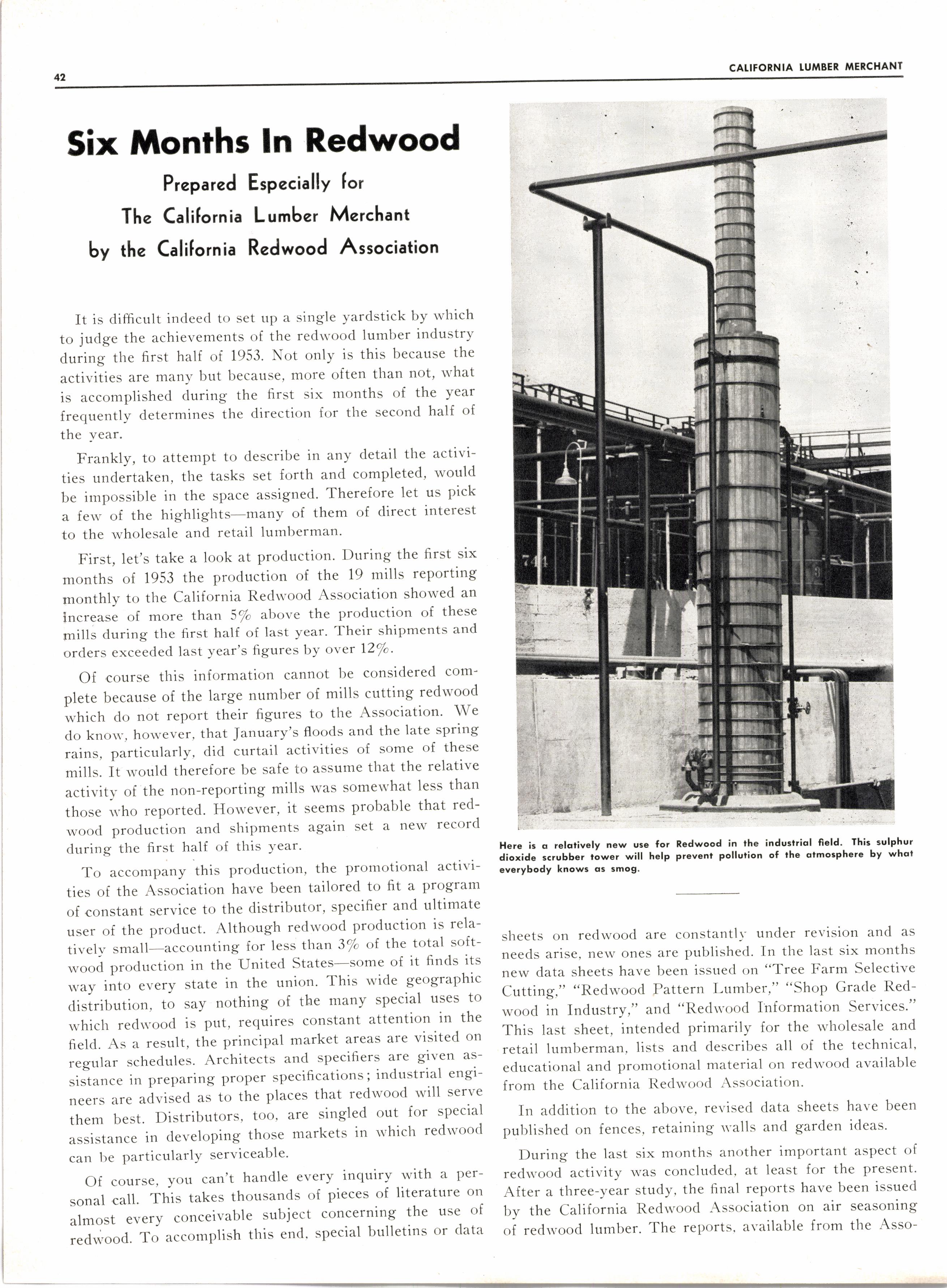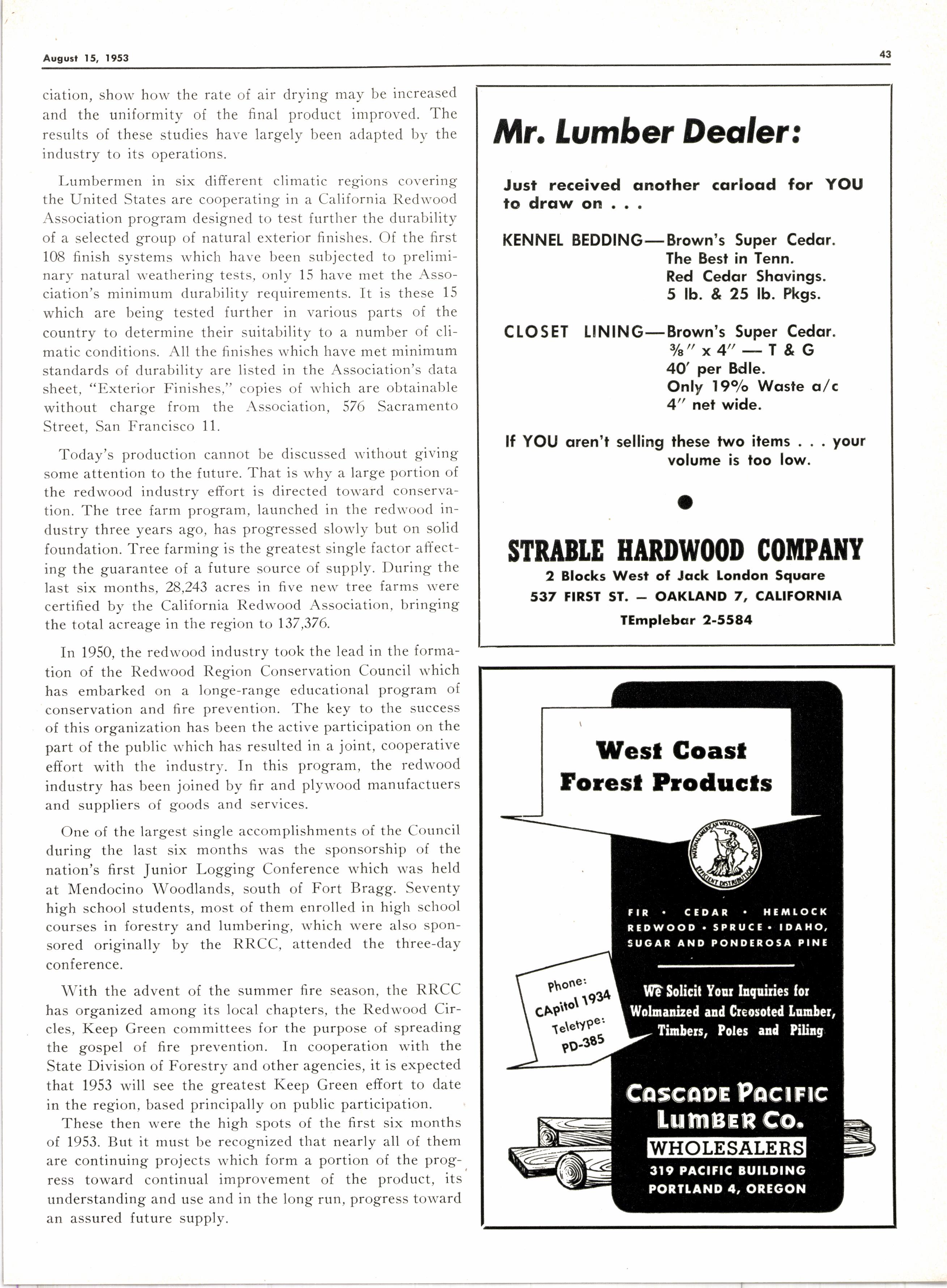
4 minute read
Six Months ln Redwood
Prepared Especially for Ths California Lumbcr Merchant
by thc California Redwood
Association
It is difficult indeed to set up a single yardstick by which to juclge the achievements of the redu'ood lumber industry during- the first half of 1953' Not only is this because the activilies are many but because, more often than not, r'vhat is accomplished during the first six months of the year frequentll, determines the direction for the second half oi the vear.
Frankly, to attempt to describe in any detail the activities undertaken, the tasks set forth and completed, would be impossible in the space assigned. Therefore let us pick a fen, of the highlights-many of them of direct interest to the wholesale and retail lumberman'
First, let's take a look at production' During the first six months of 1953 the production of the 19 mills reporting monthly to the California Redn'ood Association showed an increase of more than 5/o above the production of these mills during the first half of last year' Their shipments and orders exceeded last year's figures by over l2/o'
OI course this information cannot be considered complete because of the large number of mills cutting redwood which clo not report their figures to the Association' We do knol', horvever, that January's floods and the late spring rains, particularly, did curtail activities of some of these mills. It rvould therefore be safe to assume that the relative activitv of the non-reporting mills was somewhat less than those ivho reported. Horvever, it seems probable that redwood production and shipments again set a new record during the first half of this 1'ear'
To accompany this production, the promotional activities of the Association have been tailored to fit a program of constant service to the distributor, specifier and ultimate user of the product. Although redrvood production is relatively small-accounting for less lhan 3o/o of the total softnrooi prod.rction in the United' States-some of it finds its rvay into every state in the union' This wide geographic distribution, to say nothing of the many special uses to rvhich redn'ood is pttt, requires constant attention in the field. As a result, the principal market areas are visited on regular schedules. Architects and specifiers are given as,iJ"rt.. in preparing proper specifications; industrial engineers are advised as to the places that redrvood will serve them best. Distributors, too' are singled out for special assistance in cleveloping those markets in u'hicl-r redrvood can be particularly serviceable'
Of course, you can't handle every inquiry with a personal 'ca11' TtLis takes thousands of pieces of literature on almost elrery conceivable subject concerning the use of red*ood. To u..o*plish this end' special bulletins or clata sl.reets on redrvood are constantl-r- under revision and as needs arise, new ones are published. In the last six months new data sheets have been issued on "Tree Farm Selective Cutting," "Redwood Pattern Lumber," "Shop Gracle Redwood in Industry," and "Redn'ood Information Services'" This last sheet, intended primarily for the rvholesale and retail lumberman, lists and describes all of the technical' educational and promotional material on redu'ood averilable from the California Red'uvood Association'
In addition to the above. revised data sheets have been published on fences, retaining l'alls and garden ideas'
During the last six months another important aspect of redu,ood activity u'as concluded' at least {or the present' After a three-year study, the final reports have been issued by the California Redrvood Association on air seasoning of redn ood lumber. The reports. available from the Asso- ciation, show how the rate of air drying may be increased and the uniformity of the final product improved. The results of these studies have largely been adapted by the industry to its operations.
Lumbermen in six different climatic regions covering the United States are cooperating in a California Redr,vood Association program designed to test further the durability of a selected group of natural exterior finishes. Of the first 108 finish systems which have been subjected to preliminary natural weathering tests, only 15 have met the Association's minimum durability requirements. It is these 15 which are being tested further in various parts of the country to determine their suitability to a number of climatic conditions. All the finishes which have met minimum standards of durability are listed in the Association's data sheet, "Exterior Finishes," copies of r.vhich are obtainable without charge from the Association, 576 Sacramento Street, San Francisco 11.
Today's production cannot be discussed r'vithout giving some attention to the future. That is why a large portion of the redwood industry effort is directed toward conservation. The tree farm program, launched in the redwood industry three years ago, has progressed slowly but on solid foundation. Tree farming is the greatest single factor affecting the guarantee of a future source of supply. During the last six months, 28,243 acres in five new tree farms rvere certified by the California Redwood Association, bringing the total acreage in the region to 137,376.
In 1950, the redwood industry took the lead in the formation of the Redwood Region Conservation Council which has embarked on a longe-range educational program of conservation and fire prevention. The key to the success of this organization has been the active participation on the part of the public which has resulted in a joint, cooperative effort with the industry. In this program, the redrvood industry has been joined by fir and plyn'ood manufactuers and suppliers of goods and services.
One of the largest single accomplishments of the Council during the last six months 'ivas the sponsorship of the nation's first Junior Logging Conference which was held at Mendocino Woodlands, south of Fort Bragg. Seventy high school students, most of them enrolled in higl-r school courses in forestry and lumbering, which were also sponsored originally by the RRCC, attended the three-day conference.

With the advent of the summer fire season, the RRCC has organized among its local chapters, the Redwood Circles, Keep Green committees for the purpose of spreading the gospel of fire prevention. In cooperation with the State Division of Forestry and other agencies, it is expected that 1953 will see the greatest Keep Green effort to date in the region, based principally on public participation.
These then were the high spots of the first six months of 1953. But it must be recognized that nearly all of them are continuing projects which form a portion of the progress toward continual improvement of the product, its understanding and use and in the long run, progress toward an assured future supply.










